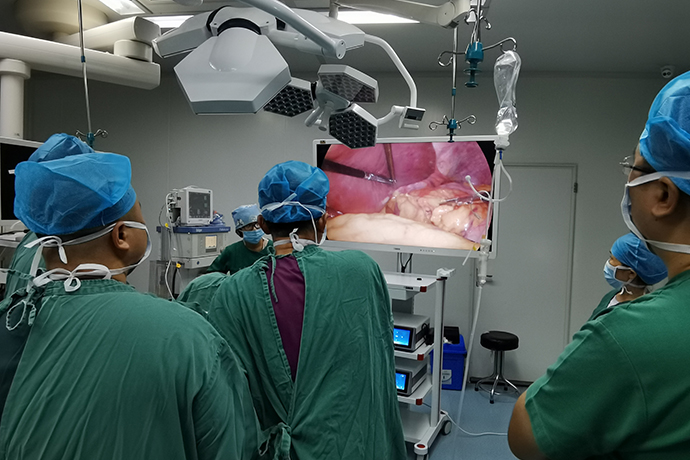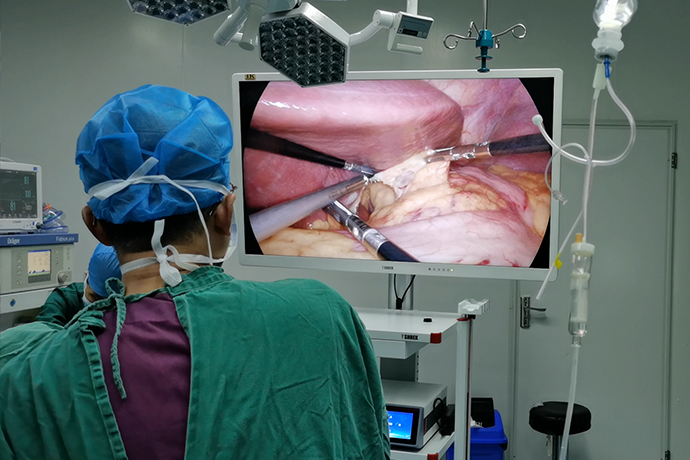[General Surgery Laparoscopy] 4K ultra-high definition laparoscopy for distal gastric cancer radical resection
Release time: 09 Apr 2024 Author:Shrek
Laparoscopic radical gastrectomy is a common method for minimally invasive surgery for early-stage gastric cancer. 4K ultra-high-definition laparoscopic radical gastrectomy is a new surgical method that has been gradually developed in recent years. This technology makes a 0.5 to 1 cm hole in the abdominal wall, inserts a 1 cm diameter laparoscope, and removes the abdominal organs. The image is clearly displayed on the LCD screen. While the doctor is looking at the screen, he inserts tiny instruments through the small hole in the abdominal wall to complete the operation, which requires an incision of more than 20 square meters in traditional surgery. Moreover, due to the video magnification of laparoscopy, doctors can better identify anatomical structures, perform more precise operations, and clean gastric lymph nodes more thoroughly. Finally, the removed tissue is removed from the body through a small incision of 3 to 6 cm. This operation has the advantages of less trauma, less interference with the gastrointestinal tract, less bleeding (basically no need for blood transfusion), mild post-operative pain, quick postoperative patient recovery, small incision scars, and significantly reduced postoperative complications. In addition, laparoscopic surgery can avoid laparotomy which is meaningless or even harmful for patients with advanced gastric cancer.

1. Indications for surgery
Early gastric antrum cancer. D2 lymph node dissection can also be performed for advanced gastric antrum cancer.
2. Contraindications to surgery
(1) Gastroduodenal ulcer and acute massive bleeding.
(2) Gastric cancer with lymph node metastasis that is estimated to be difficult to clean laparoscopically.
(3) Patients with a history of upper abdominal surgery and extensive upper abdominal adhesions are relative contraindications.
(4) Those with severe bleeding tendency and combined with insufficiency of important organs such as heart and lungs who cannot tolerate anesthesia and surgery.
3. Special instruments and equipment
Needle-holding forceps, fan-shaped retractors, ultrasonic scalpels, 5mm and 10mm laparoscopic gastrointestinal grasping forceps, and linear cutting staplers: 45mm, 35mm, and 60mm nail bins need to be prepared, and blue nails, green nails, and white nails are needed respectively. Staple the blood vessels and gastric wall, and use a 12mm puncture cannula.
4. Special preparation before surgery
(1) Correct anemia and supplement nutrients and vitamins.
(2) For patients with pyloric obstruction, gastric lavage should be performed before surgery and fluids should be changed for 3 days. Fasting and continuous gastric decompression are required if necessary.
(3) Those with water and electrolyte imbalances should be corrected. People with anemia should receive blood transfusions.
(4) Normal saline enema the night before surgery.
(5) Indwell a gastric tube before surgery to evacuate the gastric contents.
5. Anesthesia method
General anesthesia with endotracheal intubation.
6. Body position and puncture port location
The patient is in the supine position with legs spread apart, or in the lithotomy position.
There are 4 to 5 abdominal wall puncture locations for laparoscopic radical gastrectomy, among which the umbilicus needs to be extended downward to facilitate the removal of surgical specimens.
Postoperative observation and treatment
1. During fasting, pay attention to water and electrolyte balance and provide intravenous nutritional support.
2. Keep the gastrointestinal decompression and smoothness, intestinal motility will recover 2 to 3 days after the operation, and the gastric tube can be removed after anal exhaust.
3. After the gastric tube is removed, a small amount of fluid can be given. Usually, full fluid can be given on the 5th day after the operation, semi-liquid on the 8th day after the operation, and soft rice can be eaten on the 14th day after the operation.
4. Apply antibiotics.
5. Most gastric cancer patients are frail, and the operation time is long, so they must be closely observed after surgery.

- Recommended news
- 【General Surgery Laparoscopy】Cholecystectomy
- Surgery Steps of Hysteroscopy for Intrauterine Adhesion
- [Gynecological Hysteroscopy] Techniques for Preventing and Treating Complications of Hysteroscopic Surgery
- [Gynecological Hysteroscopy] Hysteroscopic Adhesiolysis
- [Gynecological Hysteroscopy] IUD Removal under Hysteroscopy